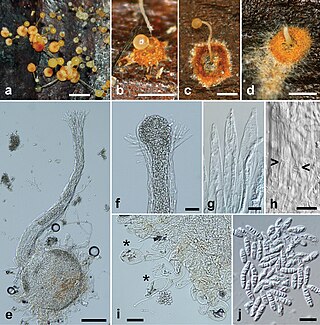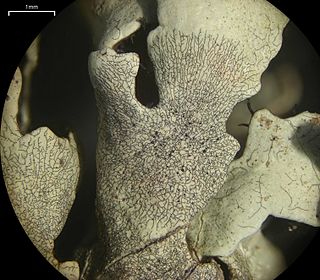Sporidiales was an order in the kingdom of Fungi. It contained the family Sporidiobolaceae.

Tremella is a genus of fungi in the family Tremellaceae. All Tremella species are parasites of other fungi and most produce anamorphic yeast states. Basidiocarps, when produced, are gelatinous and are colloquially classed among the "jelly fungi". Over 100 species of Tremella are currently recognized worldwide. One species, Tremella fuciformis, is commercially cultivated for food.

David Leslie Hawksworth is a British mycologist and lichenologist currently with a professorship in the Universidad Complutense de Madrid in Madrid, Spain and also a Scientific Associate of The Natural History Museum in London. Hawksworth has had a prolific career, authoring nearly 600 scientific works, describing approximately 250 new taxa, and proposing around 500 new combinations or new names in fungal nomenclature. In 1996, he was honoured as Commander of the British Empire (CBE). In 2002, he received the Acharius Medal from the International Association for Lichenology. Five genera and many species have been named in his honour.

The Agaricostilbomycetes are a class of fungi in the subdivision Pucciniomycotina of the Basidiomycota. The class consists of a single order, six families, and 15 genera. Its type genus, Agaricostilbum was originally placed in Ascomycota, and later, Agaricomycotina, before being placed in Pucinniomycotina.
The Cystobasidiomycetes are a class of fungi in the subdivision Pucciniomycotina of the Basidiomycota. Most species are known from their yeast states; hyphal states, when present, produce auricularioid basidia and are frequently parasites of other fungi. The class contains five orders as well as two families and one genus (Queiroziella) of uncertain disposition. An additional order, Cyphobasidiales, has been proposed to accommodate several lichenicolous species, but its separation from the Erythrobasidiales has not been demonstrated.

The Microbotryomycetes are a class of fungi in the subdivision Pucciniomycotina of the Basidiomycota. The class currently contains eight orders, plus three additional, unassigned families, plus seven additional, unassigned genera. Many species are known only from their yeast states. Species with hyphal states typically produce auricularioid basidia and are often parasitic on other fungi or plants. Several species in the genera Rhodotorula and Sporobolomyces are opportunistic human pathogens.
Bulleribasidium is a genus of fungi in the family Bulleribasidiaceae. The genus currently contains some eleven species. The type species is a parasite of other fungi, its teleomorph having septate basidia and haustorial cells on its hyphae that connect to the host hyphae. Most species are, however, only known from their yeast states.
Kwoniella is a genus of fungi in the family Cryptococcaceae. The genus originally contained the single species Kwoniella mangrovensis, found in the Florida Everglades and The Bahamas. Molecular research, based on cladistic analysis of DNA sequences, has however, now extended the genus to eleven species, most known only from their yeast states.

The Heterogastridiales are an order of fungi in the class Microbotryomycetes. The order contains a single family, the Heterogastridiaceae, which currently contains five genera. Some species in the order are currently known only from their yeast states. Those producing hyphal states have auricularioid basidia and are parasitic on other fungi. Basidiocarps, when present, are minute and variously stilboid (pin-shaped), pustular, or pycnidioid (flask-shaped). Molecular research, based on cladistic analysis of DNA sequences, has shown that the order is a monophyletic (natural) group, though the type and only species of Krieglsteinera has not yet been sequenced and may belong elsewhere.
Leucosporidium is a genus of fungi in the subdivision Pucciniomycotina. The genus comprises fungi that are mostly known from their yeast states, though some produce hyphal states in culture that give rise to teliospores from which auricularioid basidia emerge. Species known only from their anamorphic yeast states were formerly referred to the genus Leucosporidiella, but, following changes to the International Code of Nomenclature for algae, fungi, and plants, the practice of giving different names to teleomorph and anamorph forms of the same fungus was discontinued, meaning that Leucosporidiella became a synonym of the earlier name Leucosporidium. Species have been isolated predominantly from cold environments and are regarded as psychrotolerant.

The Kriegeriales are an order of fungi in the subdivision Pucciniomycotina. Most species are known only from their yeast states and can be found in a variety of habitats, ranging from arctic waters to tropical ferns. Hyphal states produce auricularioid basidia.
Mrakia frigida is a species of fungus in the order Cystofilobasidiales. The species occurs in both a yeast and hyphal state, the latter producing teliospores from which basidia emerge. It was originally isolated in its yeast state from Antarctic snow.

Lichenostigmatales is an order of fungi in the class Arthoniomycetes. It contains the single family Phaeococcomycetaceae. Lichenostigmatales was circumscribed in 2014 by Damien Ertz, Paul Diederich, and James D. Lawrey, with genus Lichenostigma assigned as the type. Using molecular phylogenetics, they identified a lineage of taxa in the Arthoniomycetes that were phylogenetically distinct from the order Arthoniales. Species in the Lichenostigmatales include black yeasts, lichenicolous, and melanised rock-inhabiting species.

Phaeotremella is a genus of fungi in the family Phaeotremellaceae. All Phaeotremella species are parasites of other fungi and produce anamorphic yeast states. Basidiocarps, when produced, are gelatinous and are colloquially classed among the "jelly fungi". Fifteen or so species of Phaeotremella are currently recognized worldwide. Tremella sanguinea, shown to be a Phaeotremella species by DNA sequencing, is cultivated in China as an ingredient in traditional Chinese medicine.
Pseudotremella is a genus of fungi in the family Bulleraceae. All Pseudotremella species are parasites of other fungi and produce anamorphic yeast states. Basidiocarps, when produced, are gelatinous and are colloquially classed among the "jelly fungi". Four species of Pseudotremella are currently recognized worldwide. Two of these species are, as yet, only known from their yeast states.
Ruineniaceae is a family of fungi in the order Agaricostilbales. The family contains a single genus. Species are known only from their yeast states.
The Spiculogloeales are an order of fungi in the subdivision Pucciniomycotina of the Basidiomycota. The order is currently monotypic, consisting of a single family, the Spiculogloeaceae. Species in the genus Phyllozyma are currently known only from their yeast states. Species in the genus Spiculogloea form hyphal states that produce auricularioid basidia and are parasitic on other fungi.
Cystobasidium is a genus of fungi in the order Cystobasidiales. The type species is a fungal parasite forming small gelatinous basidiocarps on various ascomycetous fungi on dung. Microscopically, it has auricularioid basidia producing basidiospores that germinate by budding off yeast cells. Other species are known only from their yeast states. The yeasts Cystobasidium minutum and C. calyptogenae are rare but known human pathogens.

The Kriegeriaceae are a family of fungi in the subdivision Pucciniomycotina. The family currently comprises four genera, one of which (Kriegeria) contains a plant pathogenic species with auricularioid basidia. The other genera contain species currently known only from their yeast states.
The Camptobasidiaceae are a family of fungi in the subdivision Pucciniomycotina. The family currently comprises two genera, one of which (Camptobasidium) contains an aquatic, hyphal species with auricularioid basidia. The other genus contains species currently known only from their yeast states.








